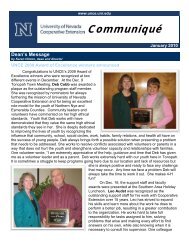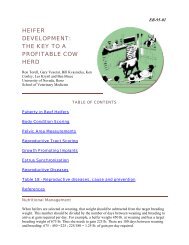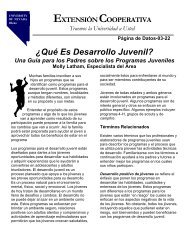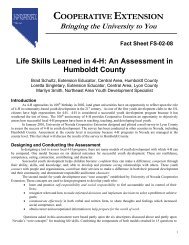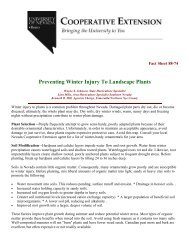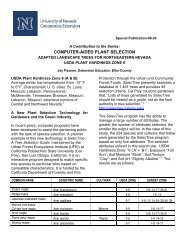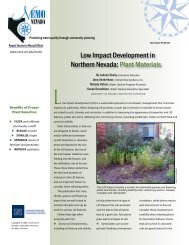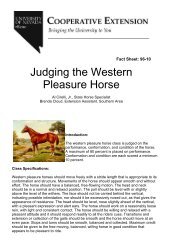Managing Mayweed Chamomile - University of Nevada Cooperative ...
Managing Mayweed Chamomile - University of Nevada Cooperative ...
Managing Mayweed Chamomile - University of Nevada Cooperative ...
You also want an ePaper? Increase the reach of your titles
YUMPU automatically turns print PDFs into web optimized ePapers that Google loves.
COOPERATIVE EXTENSION<br />
Bringing the <strong>University</strong> to You<br />
Fact Sheet-04-08<br />
<strong>Managing</strong> <strong>Mayweed</strong> <strong>Chamomile</strong><br />
Jessica Graham, Undergraduate Research Assistant, <strong>University</strong> <strong>of</strong> <strong>Nevada</strong>, Reno<br />
Wayne S Johnson; Associate Pr<strong>of</strong>essor, Applied Economics and Statistics, College <strong>of</strong> Agriculture Biotechnology and Natural<br />
Resources; IPM Specialist, <strong>University</strong> <strong>of</strong> <strong>Nevada</strong> <strong>Cooperative</strong> Extension<br />
<strong>Mayweed</strong> chamomile, commonly called<br />
stinking chamomile or dog fennel, is an illsmelling<br />
member <strong>of</strong> the Asteraceae (sunflower)<br />
family. This bushy annual is very attractive. It is<br />
native to the Mediterranean, but is now<br />
widespread throughout the Pacific Northwest,<br />
California, and <strong>Nevada</strong>, especially where<br />
irrigated agriculture has occurred. <strong>University</strong> <strong>of</strong><br />
<strong>Nevada</strong> Herbarium records show this plant<br />
present in Carson City, Douglas, Lincoln, Lyon,<br />
Storey, and Washoe Counties. <strong>Mayweed</strong><br />
chamomile quickly spreads. It has no beneficial<br />
uses, is damaging to neighboring plants, and is<br />
potentially harmful to humans and livestock.<br />
Identification<br />
<strong>Mayweed</strong> chamomile (Anthemis cotula L.)<br />
has small, oval seed leaves (cotyledons). They<br />
are thick and smooth with green stems that<br />
become maroon on the underside with age.<br />
They are rarely seen, though, because they dry<br />
up rapidly.<br />
The first true leaves grow opposite <strong>of</strong> each<br />
other on the stem, and are pointed and deeply<br />
divided. Subsequent leaves grow alternately<br />
along the stems, sparsely produce short hairs,<br />
and are finely divided several times (Fig. 1).<br />
Figure 1. Leaves are arranged alternately and<br />
are divided into narrow segments.<br />
They release a distinctly foul odor and grow<br />
about three-quarters to two and one-half inches<br />
long and one inch wide.<br />
The mature plant is one-half foot to two feet<br />
tall with erect, branching, hairless stems. The<br />
plant produces a tap root and an extensive,<br />
fibrous root system that grows near the soil’s<br />
surface.<br />
Flowers are borne at the ends <strong>of</strong> branches<br />
and on one and one-half to four inch long,<br />
unbranched stalks in the axils <strong>of</strong> the leaf from<br />
May to October. The many yellow disk flowers<br />
are surrounded by twelve (up to twenty) white<br />
ray flowers in one head (Fig. 2). The white ray<br />
flowers each have three distinct teeth at their<br />
tips. Flower heads are about three-quarters to<br />
one inch in diameter, and the bracts (involucres)<br />
at their bases are lightly hairy.<br />
Figure 2. Daisy-like heads <strong>of</strong> yellow disk and<br />
white ray flowers bloom from May to October.<br />
Each flower head produces numerous<br />
(thousands per plant) single, smooth seeds<br />
(achenes). Each is about one-sixteenth inch<br />
long and inside a covering with ten ribs that run<br />
lengthwise along the seed. Germination <strong>of</strong> the<br />
seeds occurs spring through fall, and seeds<br />
remain viable in the soil for many years. Seeds<br />
are the only way mayweed chamomile spreads.
Corn chamomile (Anthemis arvensis L.) may<br />
be confused with mayweed chamomile. They<br />
are nearly identical, but corn chamomile does<br />
not produce a foul odor when the leaves are<br />
crushed. Pineapple-weed (Chamomilla<br />
matricarioides (Less.) Porter) is also a similar<br />
species, but the flower does not have ray<br />
flowers, and the leaves <strong>of</strong> mayweed chamomile<br />
are more finely divided. The leaves <strong>of</strong><br />
pineapple-weed tend to clasp the stem and they<br />
give <strong>of</strong>f a pineapple scent when crushed.<br />
Habitat<br />
This European native is now found<br />
worldwide. Infestations have been limited to<br />
low, wet areas, but mayweed chamomile is now<br />
found in other areas. It adapts to various<br />
growing conditions, but prefers heavily<br />
disturbed, rich, gravelly soil. It is commonly<br />
found in waste areas, barnyards, cultivated<br />
fields, roadsides, alfalfa fields, meadows,<br />
overgrazed pastures, dry tailwater ponds, and<br />
along ditches, particularly if moisture is available<br />
or regularly applied.<br />
Threat<br />
Caution: Contact with mayweed chamomile<br />
can cause skin rashes to workers. Livestock<br />
that graze it have blistered noses and mouths,<br />
and irritated mucous membranes. It also<br />
imparts a strong <strong>of</strong>f-flavor to the milk <strong>of</strong> dairy<br />
animals if they graze it or eat it in hay.<br />
<strong>Mayweed</strong> chamomile is competitive,<br />
allelopathic (slows or stops growth <strong>of</strong> other<br />
plants), requires control in cropping systems,<br />
and may contaminate seed crops, requiring<br />
costly seed cleaning.<br />
Weed Management Options<br />
Prevention: It is most important to prevent<br />
the production and spread <strong>of</strong> mayweed<br />
chamomile seed. Seed is dispersed by water in<br />
ditches and streams, in contaminated crop seed,<br />
and physically by animals and on equipment.<br />
Prevent seed production whenever possible,<br />
sow clean seed, manage animal movement to<br />
avoid infested areas, and clean equipment<br />
whenever it is moved from infested to uninfested<br />
areas. Minimizing soil disturbances, identifying<br />
and eliminating weed introductions early, and<br />
establishing competitive grasses are important.<br />
Revisit previously infested sites each year<br />
and eliminate any new plants. Agricultural seed,<br />
hay, and livestock feeds may become<br />
contaminated with mayweed chamomile seed.<br />
Always select and use certified weed-free<br />
forage, feed, and seed to prevent reinfestation <strong>of</strong><br />
an area. Quarantine livestock known to have<br />
been in areas infested with mayweed<br />
chamomile. It may be necessary to clean the<br />
animals’ coats and purge them by feeding them<br />
weed-free hay for five days or more before they<br />
are moved to uninfested land.<br />
Figure 3. Mature plants are bushy, one-half to<br />
two feet tall, and produce numerous flowers<br />
all season long.<br />
Mechanical Control: Isolated plants and<br />
small infestations can be removed by hand<br />
pulling and digging, but this is not practical for<br />
large infestations. Hand pulling mayweed<br />
chamomile before it goes to seed will prevent<br />
new infestations. Cultivation is most successful<br />
if done when the plant is in the seedling stage,<br />
before an extensive root system develops and<br />
before the plant flowers and produces seeds.<br />
Cultivation should be performed as <strong>of</strong>ten as<br />
necessary to control this weed.<br />
Mowing or flailing mayweed chamomile is<br />
not very effective. However, some success may
e achieved if performed immediately before the<br />
plant flowers. If mowed too early, the plant<br />
grows more prostrate and can produce flowers<br />
below the height <strong>of</strong> a mower blade set to<br />
minimize damage to other desirable plants. A<br />
second mowing may be required to remove<br />
flowers when the season is long, moisture is<br />
available and the plants regrow and flower after<br />
the first mowing.<br />
Cultural Control Control: <strong>Mayweed</strong> chamomile is<br />
not an exceptionally strong competitor, so<br />
maintain a vigorous pasture with proper<br />
irrigation, fertilizer application, and harvesting.<br />
Avoid overgrazing and excessive cultivation.<br />
Biological Control: There are currently no<br />
biological control methods available for<br />
mayweed chamomile. Manage livestock grazing<br />
to improve the competition <strong>of</strong> desirable grasses<br />
and legumes.<br />
Chemical Control: There are several<br />
herbicides available to provide control <strong>of</strong><br />
mayweed chamomile. In grasses grown for<br />
seed, the selective herbicides Buctril and Clarity<br />
can be applied and should provide adequate<br />
control.<br />
For use on small grain crops, the herbicides<br />
Ally ® , Buctril ® , Bronate ® , Canvass ® , dicamba,<br />
Express ® , Finesse ® , Glean ® , Harmony Extra ® ,<br />
Harmony GT ® , Maverick ® , Peak ® , and Tordon ®<br />
will all control mayweed chamomile. Tordon ® is<br />
a restricted use herbicide and by law can only<br />
be purchased and applied by a certified<br />
applicator or someone under his or her direct<br />
supervision.<br />
For control on noncrop sites and rights-<strong>of</strong>way,<br />
Garlon ® can be applied to mayweed<br />
chamomile. This growth regulator herbicide will<br />
cause abnormal growth, and may lead to the<br />
disruption <strong>of</strong> the phloem and prevent energy<br />
movement into the root system, which eventually<br />
kills the plant.<br />
For control in wheat, chlorsulfuron with<br />
metsulfuron (Finesse ® ), diuron (Karmex ® ,<br />
Direx ® ), thifensulfuron with tribenuron (Harmony<br />
Extra ® ), tribenuron (Express ® ), and metribuzin<br />
with chlorsulfuron will all provide excellent<br />
control <strong>of</strong> mayweed chamomile.<br />
The soil-applied herbicides diuron and<br />
terbacil (Sinbar ® ) will provide good control in tree<br />
fruits, as will the post-emergent non-selective<br />
herbicide glyphosate.<br />
Herbicides should be combined with other<br />
control methods, such as cultivation. Repeated<br />
herbicide applications may be needed to<br />
achieve control <strong>of</strong> an infestation.<br />
Always check the herbicide label before use.<br />
The label is the law and provides information to<br />
keep the applicator and others safe, along with<br />
specifics on the use <strong>of</strong> the product for various<br />
applications and rates. Proper use near water is<br />
important in this case as mayweed chamomile<br />
occurs near water and in wet meadows. As<br />
well, herbicides have different soil persistence<br />
and application rates that can affect future crops<br />
and treatment costs.<br />
References<br />
1. Ball, D.A., D. Cudney, S.A. Dewey, C.L. Elmore,<br />
R.G. Lym, D.W. Morishita, R. Parker, D.G. Swan,<br />
T.D. Whitson and R.K. Zollinger. 2001. Weeds <strong>of</strong><br />
the West. 9 th edition, Western Society <strong>of</strong> Weed<br />
Science. Pp. 54-55<br />
2. <strong>Mayweed</strong> <strong>Chamomile</strong>: Anthemis Cotula. Virginia<br />
Tech Weed Identification Guide. 22 July 2003.<br />
.<br />
3. Anthemis Cotula. Weed Programs in Oregon. 22<br />
July 2003. .<br />
4. Stinking <strong>Mayweed</strong>. Tamar Valley Weed Strategy.<br />
22 July 2003. .<br />
5. William, R.D., A.G. Dailey, D. Ball, J. Colquhoun,<br />
T.L. Miller, R. Parker, J.P. Yenish, T.W. Miller,<br />
D.W. Morishita, P.J.S. Hutchinson, M.<br />
Thompson. Pacific Northwest Weed<br />
Management Handbook. Corvallis, OR: Oregon<br />
State <strong>University</strong>, 2003. Pp. 82, 152, 227.<br />
6. Bussan, A.J., S.A. Dewey, T.D. Whitson and<br />
M.A. Trainor. 2001. Weed Management<br />
Handbook. Montana State <strong>University</strong>, Bozeman,<br />
MT. Pp. 117, 169, 235.<br />
Photographs are courtesy <strong>of</strong> Weeds <strong>of</strong> the West.<br />
Information herein is <strong>of</strong>fered with no discrimination.<br />
Listing a product does not imply endorsement by the<br />
authors, <strong>University</strong> <strong>of</strong> <strong>Nevada</strong> <strong>Cooperative</strong> Extension<br />
(UNCE) or its personnel. Likewise criticism <strong>of</strong><br />
products or equipment not listed is neither implied nor<br />
intended. UNCE and its authorized agents do not<br />
assume liability for suggested use(s) <strong>of</strong> chemical or<br />
other pest control measures suggested herein.<br />
Pesticides must be applied according to the label<br />
directions to be lawfully and effectively applied.<br />
The <strong>University</strong> <strong>of</strong> <strong>Nevada</strong>, Reno is an equal opportunity, affirmative action employer and does not discriminate on the basis <strong>of</strong> race, color, religion, sex, age,<br />
creed, national origin, veteran status, physical or mental disability or sexual orientation in any program or activity it operates. The <strong>University</strong> <strong>of</strong> <strong>Nevada</strong> employs<br />
only United States citizens and aliens lawfully authorized to work in the United ted Sta States. tes.
<strong>Cooperative</strong> Extension<br />
Office Locations<br />
Battle Mountain<br />
815 N. 2 nd St., 89820<br />
(775) 635-5565, FAX (775) 635-8309<br />
Caliente<br />
360 Lincoln St., P.O. Box 728, 89008-0728<br />
(775) 726-3109, FAX (775) 726-3332<br />
Carson City/Storey County<br />
2621 Northgate Ln., Ste. 15, 89706<br />
(775) 887-2252, FAX (775) 887-2065<br />
Elko<br />
701 Walnut Street, 89801<br />
(775) 738-7291, FAX (775) 753-7843<br />
Ely<br />
995 Campton St., 89301<br />
(775) 289-4459, FAX (775) 289-1462<br />
Eureka<br />
701 S. Main St., P.O. Box 613, 89316<br />
(775) 237-5326, FAX (775) 237-5164<br />
Fallon<br />
111 Sheckler Rd., 89406<br />
(775) 423-5121, FAX (775) 423-7594<br />
Hawthorne<br />
(775) 945-3444<br />
Incline Village<br />
865 Tahoe Blvd., Ste. 110<br />
P.O. Box 8208, 89452<br />
(775) 832-4150, FAX (775) 832-4139<br />
Las Vegas<br />
2345 Red Rock St., Ste. 100, 89146<br />
(702) 222-3130, FAX (702) 222-3100<br />
Logandale<br />
1897 N. Moapa Valley Blvd.,<br />
P.O. Box 126, 89021<br />
(702) 397-2604, FAX (702) 397-8301<br />
Lovelock<br />
810 6 th St., P.O. Box 239, 89419<br />
(775) 273-2923, FAX (775) 273-7647<br />
Administration:<br />
Karen Hinton<br />
Dean & Director<br />
hinton@scs.unr.edu<br />
Central/Northeast Area<br />
Jerry Buk, Area Director<br />
40 E. Center Street #14, Fallon 89406<br />
(775) 426-2844<br />
FAX (775) 423-1901<br />
Visit our web site: www.unce.unr.edu<br />
Minden/Gardnerville<br />
1329 Waterloo Lane, P.O. Box 338, 89423<br />
(775) 782-9960, FAX (775) 782-9968<br />
Pahrump<br />
1651 E. Calvada Blvd.,89041-1090<br />
(775) 727-5532, FAX (775) 727-6199<br />
Reno<br />
5305 Mill St., P.O. Box 11130, 89520<br />
(775) 784-4848, FAX (775) 784-4881<br />
Campus Office<br />
National Judicial College, Suite 118<br />
UNR/404, Reno 89557<br />
(775) 784-7070<br />
FAX (775) 784-7079<br />
Southern Area<br />
Dixie Allsbrook, Area Director<br />
2345 Red Rock St., Ste. 100, Las Vegas 89146<br />
(702) 222-3130<br />
FAX (702) 222-3101<br />
Tonopah<br />
1 Frankee St., P.O. Box 231, 89049<br />
(775) 482-6794, FAX (775) 482-5396<br />
Winnemucca<br />
1085 Fairgrounds Rd., 89445<br />
(775) 623-6304, FAX (775) 623-6307<br />
Yerington<br />
504 S. Main St., P.O. Box 811, 89447<br />
(775) 463-6541, FAX (775) 463-6545<br />
Las Vegas Office<br />
2345 Red Rock St., Ste. 330<br />
Las Vegas 89146<br />
(702) 251-7531<br />
FAX (702) 251-7536<br />
Western Area<br />
Mary Spoon, Acting Area Director<br />
5305 Mill St., P.O. Box 11130, Reno 89520<br />
(775) 784-4848<br />
FAX (775) 784-4881






